Asking for and Giving Directions in French
Updated: 24 April, 2021 by Elie in Guides and Tips ▪
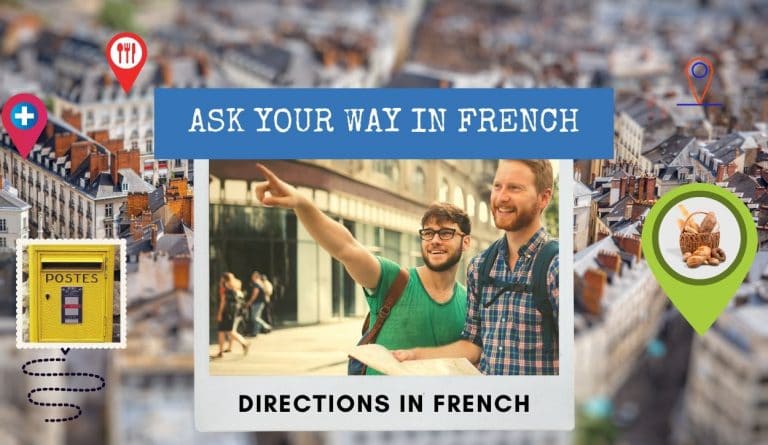
Ready to level up your travel vocabulary in French? Learn how to ask for the directions in French before you start packing. Simply learn this essential vocabulary because you’ll need it whether you’re in the city, on a hike, or in a store.
The path to learning directions in French
The aim of the French vocabulary that you’ll discover in this article is to help you learn useful terms and phrases to ask for directions in French without neglecting the listening and comprehension skills, equally important whenever you receive the answer to your question.
Therefore, in this article you’ll discover:
- The essential vocabulary to ask for directions in French
- The typical replies in French that you’ll receive from the people willing to help you
- A video to watch to listen to the pronunciation of the directions in French
- A treasure map to practice and evaluate how much vocabulary you retained from this lesson
Directions are central elements in the useful French vocabulary. Of course, our smartphones come with a wide range of apps and GPS-based technologies. However, directions aren’t just needed on the road or in the street.
Let us consider a few examples in a restaurant, in a museum, and in a supermarket where people usually ask for the directions:
- Excuse me, where are the restrooms?
- Excuse me, where can I find the information desk?
- Excuse me, where can I find cake decoration in the store?
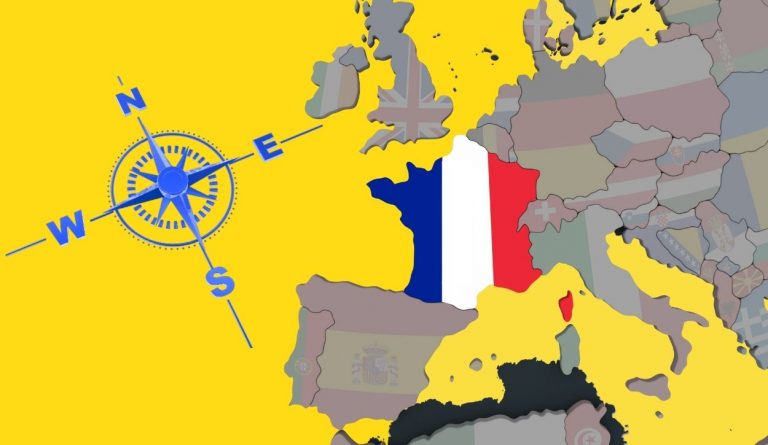
Asking for the Way in French
The first thing to study is the vocabulary that is useful to reference a specific place or an address. With these simple terms, you’ll make your journey more enjoyable, relaxing, and you’ll reduce the chances that you get lost in a French-speaking city. But of course, not all those who wander are lost.
Excusez-moi
To start a conversation with a person in the street or in a store, the first thing to say is “Excusez-moi” which means “Excuse me”. It is a polite way to grab the attention and it signals to the other person that you’d like to initiate a conversation.
Savez-vous où se trouve…
Once the other person is aware that you have something to say, then you’re good to go to ask for directions in French. Learn the following question:
- In French: Savez-vous où se trouve l’hôtel Mirabeau?
- In English: Do you know where the hôtel Mirabeau is located?
The sentence “savez-vous où se trouve” is useful whenever you’re asking about a specific place or address. Then, just complete your sentence with the name of the street, the restaurant, or any other location.
To learn how to properly ask questions in French, check the ultimate guide to ask questions in French.
Où est…
A more simple and shorter alternative is to say:
- In French: Où est l’hôtel Mirabeau?
- In English: Where is the hôtel Mirabeau?
The word “est” is the present tense of the verb “être” conjugated in the singular. The same verb in the plural is “sont” and it must be used with plural words. For instance, the word restrooms is always used in its plural form in French “les toilettes” and therefore you should say:
- In French: Où sont les toilettes publiques?
- In English: Where are the public restrooms?
Comment peut-on aller à…
Another way to ask for directions in French is to use a question that starts with “comment peut-on aller à”. Here is an example:
- In French: Comment peut-on aller à l’hôtel Mirabeau?
- In English: How to get to the hotel Mirabeau?
La plus proche or Le plus proche
Sometimes, you won’t be looking for a specific address or place. Instead, you’d like to find the closest bakery or get to the nearest metro station. In this case, add to your question “la plus proche” or “le plus proche” (nearest). Check the example below with “la plus proche” (boulangerie is a feminine noun):
- In French: Où se trouve la boulangerie la plus proche?
- In English: Where is the nearest bakery?
Let’s see an example with “le plus proche” which is used with masculine nouns such as the word distributeur. I’m using “savez-vous où se trouve” instead of “où se trouve“. Again, both options have the same meaning.
- In French: Savez-vous où se trouve le distributeur le plus proche?
- In English: Where is the nearest ATM machine?
Y a-t-il … près d’ici
Similarly, another way to ask for the nearest service, business, or boutique is to say:
- In French: Y a-t-il une pharmacie près d’ici?
- In English: Is there a pharmacy nearby?
A list of expressions in French to ask for directions
Here is a list of expessions in French, as cited above, that you can use to ask for directions:
- Savez-vous où se trouve l’hôtel Mirabeau?
- Où sont les toilettes publiques?
- Comment peut-on aller à l’hôtel Mirabeau?
- Où se trouve la boulangerie la plus proche?
- Savez-vous où se trouve le distributeur le plus proche?
- Y a-t-il une pharmacie près d’ici?
Asking for the distance in French
Est-ce que c’est près d’ici
Not sure about how far is the place from where you are? Then, ask about the distance to better know if you can get there walking or by car. To get this direction in French right, ask if it’s close from here (près d’ici) or far from here (loin d’ici):
- In French: Est-ce que c’est près d’ici?
- In English: Is it near from here?
And asking if it is far:
- In French: Est-ce que c’est loin d’ici?
- In English: Is it far from here?
Aller à pied
Do you want to be sure that you can walk there? Then, explicitly ask if you can go on foot. In this case, here is the question to ask:
- In French: Est-ce que je peux y aller à pied?
- In English: Can I walk to get there?
Saying where the place is in French
It is not only important to learn how to ask for directions in French, but also it is essential to understand the answer that you get back in French. Here are some key elements that are related to locations and directions in French:
- “A côté de” (next to):
- In French: La boulangerie est à côté de la banque.
- In English: The bakery is next to the bank.
- “En face de” (in front of):
- In French: La boulangerie est en face de la banque.
- In English: The bakery is in front of the bank.
- “A droite de” (on the right of):
- In French: La boulangerie est à droite de la banque.
- In English: The bakery is on the right of the bank.
- “A gauche de” (on the left of):
- In French: La boulangerie est à gauche de la banque.
- In English: The bakery is on the left of the bank.
- “Derrière” (behind):
- In French: La boulangerie est derrière la banque.
- In English: The bakery is behind the bank.
- “Devant” (in front of):
- In French: La boulangerie est devant la banque.
- In English: The bakery is in front of the bank.
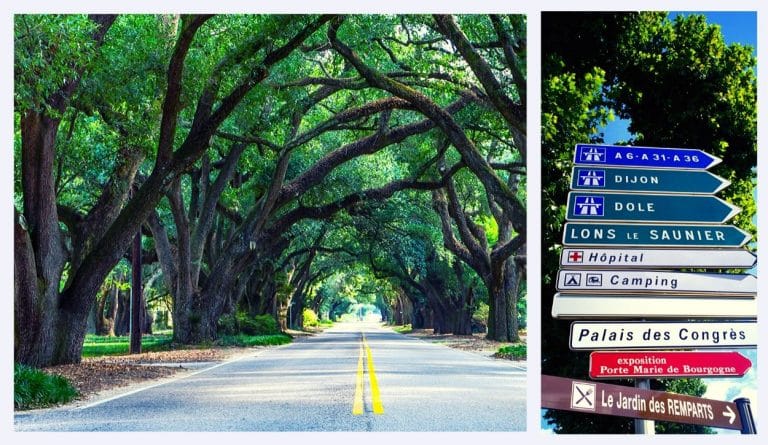
Giving information about the location in French
In the following, we’ll keep exploring additional French travel vocabulary that you need to navigate your way around.
- “Centre ville” (city center)
- In French: Le supermarché est au centre ville.
- In English: The supermarket is in the city center.
- “Au coin de” (at the corner of)
- In French: Le supermarché est au coin de la rue.
- In English: The supermarket is at the corner of the street.
- “Au bout de” (at the end of)
- In French: Le supermarché est au bout de la rue.
- In English: The supermarket is at the end of the street.
- “La prochaine rue” (next street)
- In French: Vous devez prendre la prochaine rue.
- In English: You have to take the next street.
- “La rue suivante” (next street)
- In French: Vous devez prendre la rue suivante.
- In English: You have to take the next street.
- “Première à droite” (first to the right)
- In French: Vous devez prendre la première à droite.
- In English: You have to take the first to the right.
- “Deuxième à gauche” (the second to the left)
- In French: Vous devez prendre la deuxième à gauche.
- In English: You have to take the second to the left.
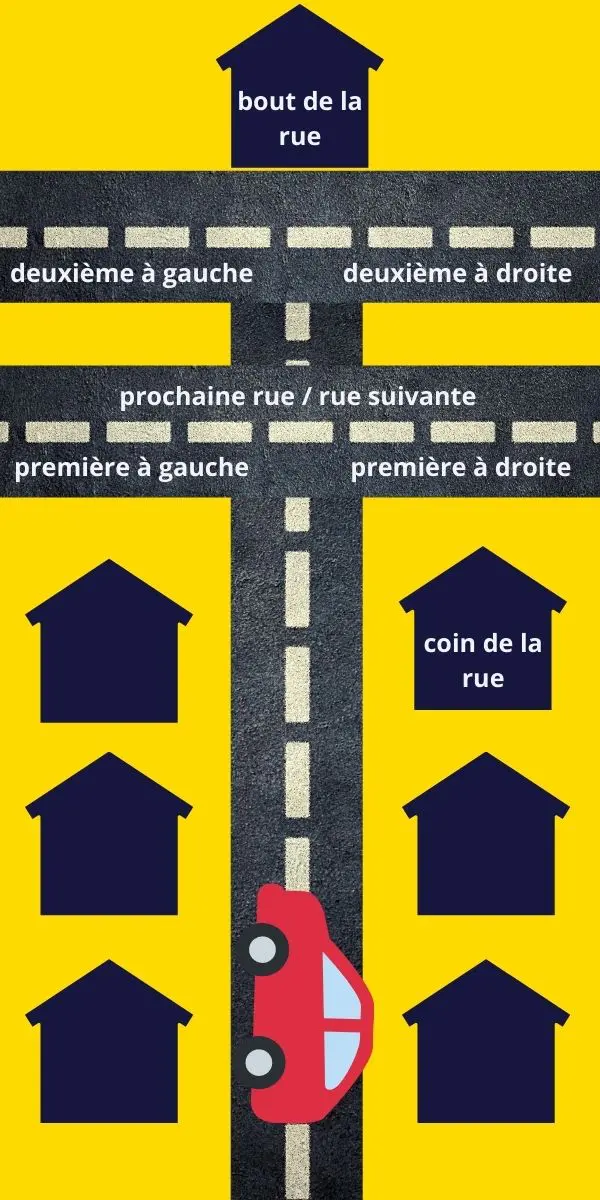
Useful Verbs for Directions in French
Now let’s take a look at the verbs:
- Traverser la rue, la route: Cross the street, the road
- Prendre à droite, à gauche: Turn to the right, to the left
- Tournez à droite, à gauche: Turn to the right, to the left. Please note that prendre and tourner have the same meaning in these sentences)
- Continuer tout droit: Go straight
- Suivre le parcours: Follow the path
French Sentence Starters
If there are a series of steps to get to your destination, you should be sure to learn the next words so that you follow the steps in the right order:
- Tout d’abord means first
- Puis means next
- Ensuite means then
- Enfin means finally
Finalement, vous êtes arrivés à destination! Finally, you got to your destination!
A video to learn how to say Directions in French
Be sure to watch the video to learn more about asking and giving directions in French and leave a comment. To follow more updates, subscribe to the YouTube channel and follow Master Your French on Instagram.
Treasure hunt: Practice time
We’re going to give directions to a pirate to find the shortest path to get to the treasure. While this isn’t something that any of us will encounter in real life, the aim of this exercise is to practice what you just learned on the topic of how to give and ask for directions in French.
We’ll be using the old island map that is just below.
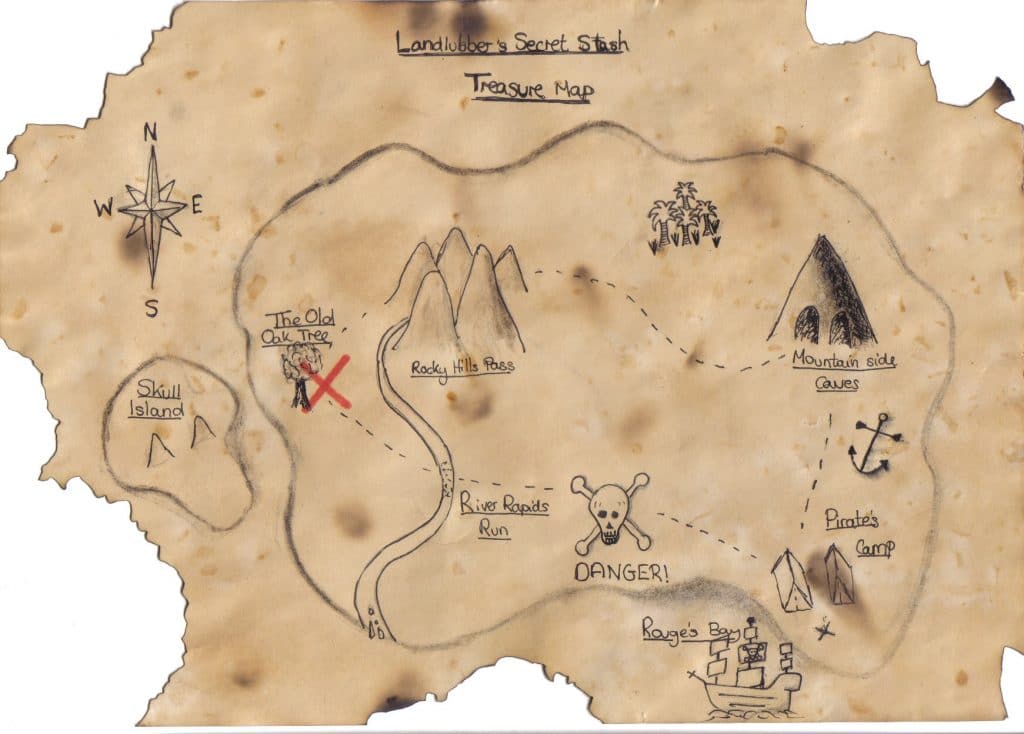
Exercice: Giving directions in French
The pirates got onto the island, set up their camping, and now they are ready to start the treasure hunt. The starting point is the camping located at the bottom of the image, not far from the boat. Here are the directions in English:
- The camping is located in the south of the island.
- Don’t head to the west.
- Instead, go to the north.
- The Mountain Side Caves will be in front of you.
- There is no point to go east, it is only the ocean that way.
- Start heading west.
- To the right, there are some palm trees.
- Keep going straight and you’ll get to the Ricky Hills Pass.
- You’ll find a small river once the Rocky Hills are behind you.
- At this point, you’ll be very close to the treasure.
- Keep going forward until you find the Old Oak Tree.
- Make 3 steps to the left and then 5 steps to the right.
- Dig under the ground and you’ll get the treasure.
Here are the directions in French:
- Le campement est au sud de l’île.
- N’allez pas vers l’ouest.
- Allez vers le nord.
- Les Mountain Side Caves seront en face de vous.
- Ce n’est pas utile d’aller vers l’est, il y a seulement l’océan dans cette direction.
- Dirigez-vous vers l’ouest.
- A votre droite, il y a des palmiers.
- Continuez tout droit et vous allez arriver aux Rocky Hills Pass.
- Vous allez trouver un fleuve une fois que les Rocky Hills seront derrière vous.
- A ce point, vous êtes tout près du trésor.
- Continuez d’avancer jusqu’à ce que vous trouviez The Old Oak Tree.
- Faites 3 pas à gauche et puis 5 pas à droite.
- Creusez sous le sol pour récupérer le trésor.
Where to go from here?
Tout d’abord, revisit some of your French vocabulary. You can check the beginner’s guide to learn French vocabulary.
Puis, go to Master Your French YouTube channel and watch the videos to learn to pronounce French. Be sure to subscribe!
Ensuite, join the French pronunciation course to boost your French language skills.
Enfin, be sure to subscribe to the newsletter so that you won’t miss similar language tips updates.
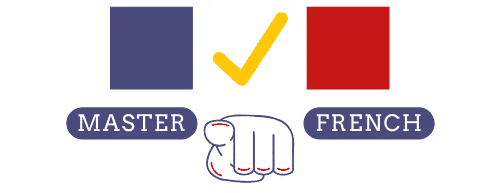

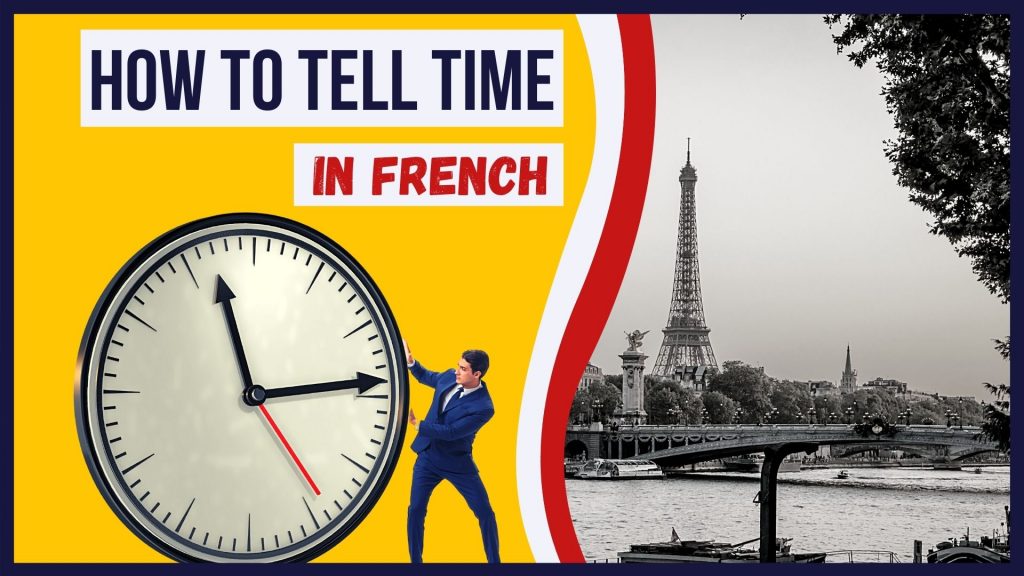
Thanks a lot, I am total beginner in French and this document helped me a lot
Bonjour Tanya! Thank you for the comment. I’m glad that you find this article helpful. Mylène
This article is very useful. thank you 🙂
Hello Dean! Thank you for the comment. A très bientôt!
Thanks so much
This is really helpful 🤗
Hello Ibrahim! Thank you for the comment. A très bientôt!
This document was really helpful.
Merci beaucoup mademoiselle
Hello Benny! Thank you for the comment. A très bientôt!
The article is really helpful. Merci 🙂